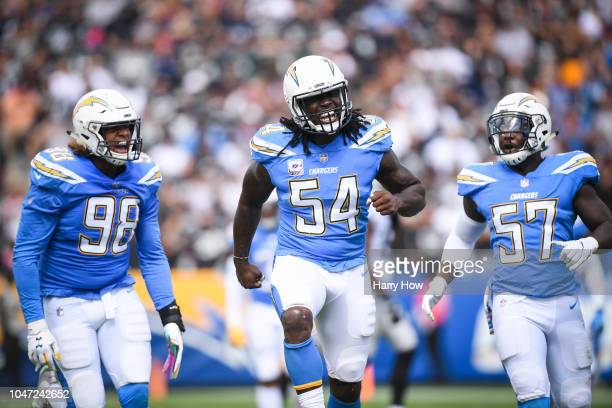Exiting the 2021 NFL Draft, the Pittsburgh Steelers defense still had two glaring holes on their depth chart, a capable third safety, which seemingly has yet to be filled, and a capable third outside linebacker to join Alex Highsmith and TJ Watt in the rotation at roughly 15 snaps per game. Earlier today, it was announced that Melvin Ingram, a versatile edge rusher who was named to the Pro Bowl in three straight seasons before struggling with injuries in 2020, was signing with the team on a one year deal.
While it’s easy to get excited about the versatility Ingram adds as a push rusher, given his ability to rush both off the edge as well as aligning over the guards on the interior, I’ve decided to look specifically in his ability to affect the pass game outside of traditional quarterback hits, hurries, and sacks. After combing through Ingram’s 2018-20 tape, I was unable to find many clips of him working in space as a traditional coverage player, but regardless, I found myself extremely impressed with his football IQ, particularly when defending quick games.
Over the past three seasons, Ingram recorded 10 passes defended and three interceptions, only one of which came with him playing as an off ball coverage player. Today, we’ll be focusing on Ingram’s ability to shut down opponents’ quick game by occupying passing lanes, as well as his feel while defending screen game, before finishing with a look into his coverage work as an off ball linebacker in goal line. Although Ingram will likely fit somewhere into the 15-25 snaps per game range, I came away confident that he will be able to fit in nicely with a Pittsburgh defense that emphasizes turning tipped passes into takeaways.
Melvin Ingram Affecting Quick Game Passing Lanes
Much like his new teammate TJ Watt, Ingram has always had a great sense of anticipating quick game, and getting his hands up in throwing lanes when he won’t have time to get home. Early this past season against Pat Mahomes and the Kansas City Chiefs, Ingram notices Clyde Edwards-Helaire slip out of the backfield on a swing route during his get off, taking a wider path to stay clean of Eric Fisher’s block, and elevating with two hands to bat the pass down at the line of scrimmage.
Note Ingram’s eyes, always on a swivel off the snap, allowing him to diagnose quick game and adjust his pass rush plan instantaneously to occupy Mahomes intended passing lane, disrupting what should be a rhythm throw and easy completion.
Over his career, teams have begun to identify Ingram’s propensity to occupy passing lanes, and have adjusted their game plans to nullify his impact in the short passing game, as we see on the rep below, a designed swing pass to Josh Jacobs from Week 6 in 2019. At the snap, Ingram attacks Trent Brown’s pass set before fending off a cut block, maintaining his footing, and elevating to bat the pass down with his left hand. Fending off a cut block from the league’s heaviest player deserves praise on its own, but maintaining balance to disengage and elevate to secure the pass breakup showcases Ingram’s unique combination of strength and athleticism.
Ever observant, Ingram consistently punishes opposing passers for locking onto a target prematurely, even on simple quick game reads, as we see here in a 2019 matchup against Pat Mahomes and the Kansas City Chiefs. At the snap, Ingram fends off a physical chip from Travis Kelce, getting into Eric Fisher’s chest before reading Mahomes eyes and disengaging to elevate and secure another two handed pass breakup.
It’s important to note that while a majority of balls batted at the line of scrimmage fall harmlessly to the turf, they will occasionally ricochet to teammates in coverage at the second level, particularly in Pittsburgh which has feasted on tipped ball takeaway opportunities since Teryl Austin’s arrival in 2019.
Potentially his most impressive rep in defending quick game came in a 2018 matchup against the Tennessee Titans, where Ingram stayed home against the RPO slant , nearly securing an interception on a timing throw by Marcus Mariota. On the play design, Mariota is reading middle linebacker Denzel Perryman, understanding that if he flows with the run action, the slant window will be open immediately. Ingram is left unblocked, as it is assumed by the offensive coordinator that any edge rusher will immediately flow down the line with the run action, removing themselves from the slant window.
At the snap, Ingram begins to flow down the line with the outside zone run action before stopping instantaneously and elevating, nearly securing an interception that hit him square in the chest. As a player, plays like these will always stand out to me as something identified in the film room, likely a formation, hash, or down and distance based tendency, as there is a clear attempt made by Ingram to bait Mariota into pulling the pin on the quick slant.
As Steelers witnessed first hand in their Week 13 defeat at the hands of the Washington Football Team, tendencies can help players in the front seven predetermine quick game, and occupy passing lanes rather than engaging in futile attempts at rushing the passer. In a 2019 game against the Kansas City Chiefs, Melvin Ingram does just that, walking inside of Travis Kelce pre snap before approaching Eric Fisher from distance, keeping his feet hot, and elevating to bat down a pass intended for Darrel Williams in the flat.
As I noted Ingram’s ability to affect occupy passing lanes amid his pass rush reps should help him fit right in alongside TJ Watt, Cam Heyward, Stephon Tuitt and company, while helping him add value even if it turns out he has lost a step in the pass rush department, which is far from a certainty.
Melvin Ingram Shutting Down Screen Game
While his work in shutting down short passing lanes is enticing, I found myself wildly impressed by Ingram’s natural feel for diagnosing and shutting down opposing teams in their attempts to attack him in the screen game. Midway through their Week 1 contest against the Cincinnati Bengals this past season, Ingram attacks the Bengals left tackle, initially getting sealed off inside before identifying Gio Bernard slip out for a screen pass amid his spin move counter.
From there, Ingram flips his eyes back to Joe Burrow, blanketing the back toward the sideline and securing a timely interception on an errant shovel pass by the rookie quarterback. While the rep showcases Ingram’s football IQ and relentless motor, it also shows his ability, even at age 32, to function as an athlete in open space and effectively cover a talented receiving back, no small task for an edge rusher.
While Melvin Ingram possesses great functional strength, and thus has little trouble setting the edge in the run game, he can similarly hold the point of attack effortlessly in the screen game. In a 2019 game against Kansas City, the Chiefs unwisely opt to run a play action screen right at Melvin Ingram, once again relying on Eric Fisher to neutralize the talented edge in an isolated matchup, a plan which predictably fails.
At the snap, Engram locks Fisher out at full extension, keeping the tackle away from his body before snatching to disengage, looping around the outside, and arriving to tackle LeSean Mccoy well behind the line of scrimmage. Reps like this one showcase Ingram’s violent demeanor and relentless motor in pursuit of the football, needless to say, he’s a player who takes it personally when teams try to run in his direction.
As we saw in his defense against the quick game reps above, Ingram has great contact balance, and can create problems from quarterbacks by disengaging from offensive lineman and elevating into passing lanes instantaneously. Against Minnesota in 2019, Ingram comes downhill into a bull rush before diagnosing a screen, disengaging, and falling backwards into the passing lane to secure a pick on a screen pass intended for Ameer Abdullah.
Once again, it’s important to note the contact balance and functional strength that it takes to disengage and elevate while falling backwards into the passing lane, just elite athleticism on display here from Ingram.
While he primarily affected the screen game on running back screen’s, Melvin Ingram showed at times that he was more than athletic enough to shut down wide receiver screens to the boundary, something Bud Dupree excelled at in his time in Pittsburgh. On this 2018 rep against the Titans, Ingram flows downhill with the jet action before diagnosing screen to the boundary, flipping his hips, coming to balance, and closing to tackle the ball carrier short of the line of scrimmage.
As outside linebackers are often left unblocked on wide receiver screens, an edge with the athleticism to flip his hips and track them down near the line of scrimmage can prove invaluable.
Melvin Ingram Covering Off Ball
While I was only able to track down one rep of Ingram covering in space as an off ball linebacker, a goal line rep from a 2018 game against the Raiders, Ingram looks surprisingly natural in the role. After flowing downhill to match the play action, Ingram works to gain depth before coming to balance and elevating to secure a timely red zone takeaway on third down, keeping the Raiders off the board in a tight game.
Given that the Steelers already have two starting outside linebackers in TJ Watt and Alex Highsmith, a potential goal line package utilizing Ingram as an off ball linebacker could certainly be a creative way to get him some extra reps in a role that he can excel in.
At the end of the day, edges affect the game as coverage defenders far differently than players in the back seven. That being said, Ingram honestly reminds me a lot of Bud Dupree in coverage given his ability to retrace effortlessly in the screen game, while also being more active and effective in occupying passing lanes in his pass rush than Dupree ever was. While I’d be apprehensive to grant Ingram a full starting role in an upcoming 17 game season, I believe he can more than adequately serve a role in 15-25 snaps per game, while having the capability of filling in as a starter in case of injury.
Moreover, he will likely see snaps on third down as an interior rusher, a role which he has excelled in throughout his career as he can play both on the line and from deep. Needless to say, I wouldn’t be surprised at all to see Ingram come up with a timely interception at some point next season if a team sends one too many swing passes in his direction. Let me know what you guys think of Ingram’s coverage ability in the comments below!








